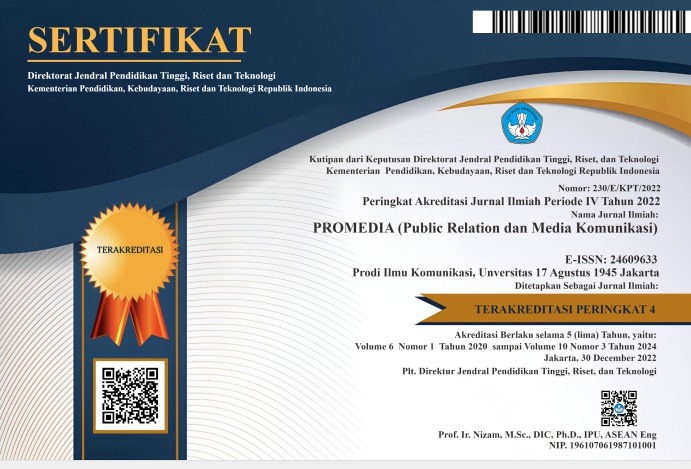EFEK PSIKOLOGIS PENGGUNAAN CONTENT DAN MEDIA KONVERGENSI SMARTPHONE PADA MAHASISWA
Abstract
Perkembangan media komunikasi saat ini telah memasuki era digital. Semua akses dari dan ke sebuah platform media bisa dilakukan melalui genggaman tangan yakni smartphone. Smartphone saat ini menjadi media yang paling banyak digunakan oleh generasi milenial, dibanding laptop maupun PC, karena dari segi kepraktisan dan kemudahan dalam membawa. Dari tahun ketahun jumlah pengguna smartphone semakin meningkat. Peningkatan ini juga ditandai dengan peningkatan akses terhadap sejumlah platform yang menjadi menu dari sebuah produk digital. Kemudahan penggunaan media digtal ini, memunculkan banyak keluhan dari penggunanya baik secara fisik maupun psikologis. Oleh karena itu, penelitian ini dilakukan untuk mengetahui gambaran efek psikologis dari penggunaan smartphone yang dialami oleh generasi milenial di universitas mercu buana. Karena efek yang dirasakan bersifat subjektif, maka penelitian ini menggunakan metode kualitatif, dengan pendekatan fenomenologi.
Kata kunci: efek psikologis, smartphone, media sosial
Full Text:
PDFReferences
Bernroider, E. W. N., Krumay, B., & Margiol, S. (2014). Not without my smartphone! Impacts of smartphone addiction on smartphone usage. New Zealand: Australasian Conference on Information Systems
Bian, M. W., & Leung, L. (2015). Smartphone addiction: Linking loneliness, shyness, symptoms and patterns of use to social capital. Media Asia, 14(2), 159-176
Bivin, J.B., Mathew, P.,Thulasi, P.C & Philip, J. (2013). Nomophobia – Do We Really Need To Worry About?. Reviews of Progress Vol -1 , ISSUE –1, 1-5
Essau, C. A. (2008). Adolescent addiction: Epidemiology, assesment, and treatment. San Diego: Elsevier, Inc.
Fromm, E. (1995). The sane society. NY: A Fawcett Premier Book
Jeong, H. S., & Lee, Y. S. (2015). Factors influencing smartphone addiction in nursing student: Focus on empathy. Information, 18(6), 2885-2890. ISSN 1343-4500
Johnson, G. M. (2005). Student alienation, academic achievement, and WebCT use. Educational Technology & Society, 8(2), 179-189.
Lee, H., Hee-June, A., & Sam-Wook, C. (2014). The SAMS: Smartphone addiction management system and verification. J Medical System, 38(1) 1-10. doi 10.1007/s10916-013-0001-1
Lepp, A., Barkley, J., & Karpinski, A. (2013). The relationship between cell phone use, academic performance anxiety, and satisfation with life in college students. Computer in Human Behavior 31 doi: 10. 1016/j.chb.2013.10.049, 343-350.
Lestari, S. (2012). Psikologi keluarga. Jakarta: Kencana
Mahardika. I. Putu, “Efek Radiasi Gelombang Elektromagnetik Ponsel terhadap Kesehatan Manusia”, 2010)
Mirowsky, J., & Ross, C. E. (2003). Social causes of psychological distress. NY: Walter de Gruyter, Inc
New Johny Wuss. Diunduh dari http://newjohnywuss.blogspot.co.id/2016/04/media-sosial-berpotensi-menimbulkan.html
Pininta. (2016, Juni 20). 4 Tanda Ponsel Mulai Mengganggu Kinerja Syaraf. Kompas.com. Diunduh dari http://health.kompas.com/read/2016/06/20/183500023/4.Tanda.Ponsel.Mulai.Mengganggu.Kinerja.Syaraf
Relations of peer group integration and friendship quality to psychological and school adjustment. Int. Migration & Integration, 535-556. doi 10.1007/s12134-012-0253-5
Santrock, J. W. (2012). Life-span development. NY: McGraw-Hill
Teja, Z., & Schonert-Reichl, K. A. (2012). Peer relations of chinese dolescent newcomers:
Widodo, M. S. (2005). Cinta dan keterasingan. Yogyakarta: Narasi
DOI: https://doi.org/10.52447/promedia.v4i2.1283
Refbacks
- There are currently no refbacks.
 |  |  |  |
 |  |  |  |
 |  |  |


